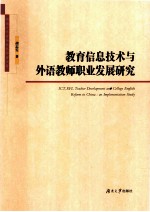图书介绍
教育信息技术与外语教师职业发展研究pdf电子书版本下载

- 胡志雯著 著
- 出版社: 长沙:湖南大学出版社
- ISBN:9787566700841
- 出版时间:2011
- 标注页数:286页
- 文件大小:107MB
- 文件页数:300页
- 主题词:高等学校-外语教学:计算机辅助教学-师资培养-研究
PDF下载
下载说明
教育信息技术与外语教师职业发展研究PDF格式电子书版下载
下载的文件为RAR压缩包。需要使用解压软件进行解压得到PDF格式图书。建议使用BT下载工具Free Download Manager进行下载,简称FDM(免费,没有广告,支持多平台)。本站资源全部打包为BT种子。所以需要使用专业的BT下载软件进行下载。如 BitComet qBittorrent uTorrent等BT下载工具。迅雷目前由于本站不是热门资源。不推荐使用!后期资源热门了。安装了迅雷也可以迅雷进行下载!
(文件页数 要大于 标注页数,上中下等多册电子书除外)
注意:本站所有压缩包均有解压码: 点击下载压缩包解压工具
图书目录
Chapter One Introduction 1
1.1 Background 1
1.2 Key Terms 3
1.2.1 Change,Reform and Innovation 3
1.2.2 ICT & ICTLE 4
1.2.3 Teacher Training,Education and Development 6
1.3 Focus of the Research 8
1.4 Significance of the Research 9
1.5 Structure of the Book 10
Chapter Two Educational Innovation:ICT Use and Continuing Professional Development 11
2.1 Introduction 11
2.2 Theories of Innovation/Change 12
2.2.1 The Theory of Diffusion of Innovations 12
2.2.2 The Theory of New Meaning of Educational Change 20
2.2.3 The Concerns-Based Adoption Model 25
2.3 The Implementation of ICT in Education 28
2.3.1 The Impact of ICT 29
2.3.2 Practice:ICT in Language Education(ICTLE) 33
2.3.3 Factors Influencing Implementation 41
2.4 Continuing Professional Development for ICT 56
2.4.1 The Role of ICT in Teacher Development 57
2.4.2 Elements of CPD 60
2.4.3 Models for CPD 70
2.4.4 ICT-Related CPD for Language Teachers 80
2.5 Conclusion 83
2.5.1 Review 83
2.5.2 Conceptual Framework 85
Chapter Three The Chinese Context:College English Reform and EFL Teacher Development 89
3.1 Introduction 89
3.2 English Teaching & Learning in Chinese Higher Education 89
3.2.1 Chinese Higher Education 89
3.2.2 English Language Teaching and Learning 92
3.2.3 ELT Pedagogy in Higher Education 94
3.3 The College English Reform 97
3.3.1 Materials 99
3.3.2 ICT Pedagogy 101
3.3.3 Evaluation 105
3.3.4 Course Design and Administration 108
3.4 EFL Teacher Development in China 110
3.4.1 A Brief Summary of Teacher Development in China 110
3.4.2 EFL Teachers' Professional Development 113
3.4.3 EFL Teacher Development for ICT 114
3.5 Conclusion 116
Chapter Four Research Methodology 117
4.1 Introduction 117
4.2 Researeh Design 117
4.2.1 Why Mixed Methods 118
4.2.2 Why a Case Study 120
4.3 Selection of Case Study Site 122
4.4 Selection of Participants 124
4.4.1 The Questionnaire Sample 124
4.4.2 The Classroom Teaching Sample 125
4.4.3 The Management and Administrative Staff Sample 127
4.4.4 The Student Sample 128
4.5 Methods Design 129
4.5.1 The Questionnaire 130
4.5.2 Classroom Observation 133
4.5.3 Semi-Structured Interviews 137
4.5.4 Focus Groups 140
4.5.5 Reliability,Validity & Triangulation 142
4.6 Data Collection Process 147
4.7 Data Management and Analysis 147
4.8 Ethical Issues 150
4.9 Conclusion 150
Chapter Five Data Analysis and Discussion 151
5.1 Introduction 151
5.2 Attitudes Towards ICT Use and the Reform 151
5.2.1 Demographic Information 152
5.2.2 ICT Use by EFL Teachers 155
5.2.3 Teachers' Attitudes 159
5.2.4 Summary 179
5.3 Profile of the Implementation of the Reform 179
5.3.1 Perceptions of New Teaching & Learning Materials 180
5.3.2 Availability of ICT Resources 186
5.3.3 Grasp of ICT Knowledge and Skills 192
5.3.4 Effects of ICT-Integrated Teaching and Learning 194
5.3.5 Institutional and Departmental Support 198
5.3.6 Overall Impact of the Reform 206
5.3.7 Summary 207
5.4 CPD Policies and Practices 208
5.4.1 Institutional Policies for CPD 209
5.4.2 Teachers' Experience and Perceptions of CPD Provision 212
5.4.3 Teachers' Needs for ICT-Related CPD 224
5.4.4 Summary 235
5.5 Further Discussion 235
5.5.1 The Role of ICT 235
5.5.2 The Role Change of Teachers 238
5.5.3 Learner Autonomy and Teacher Autonomy 239
5.5.4 An Implementation Model 240
5.5.5 An ICT-Based CPD Model 244
5.6 Conclusion 246
Chapter Six Conclusions 248
6.1 Introduction 248
6.2 Research Questions and Main Findings 248
6.3 Contributions of the Research 250
6.4 Limitations of the Research 253
6.5 Recommendations for Further Research 255
6.6 Conclusion 256
Appendix 1 258
Appendix 2 259
Appendix 3 265
Appendix 4 266
Appendix 5 267
Appendix 6 269
References 272